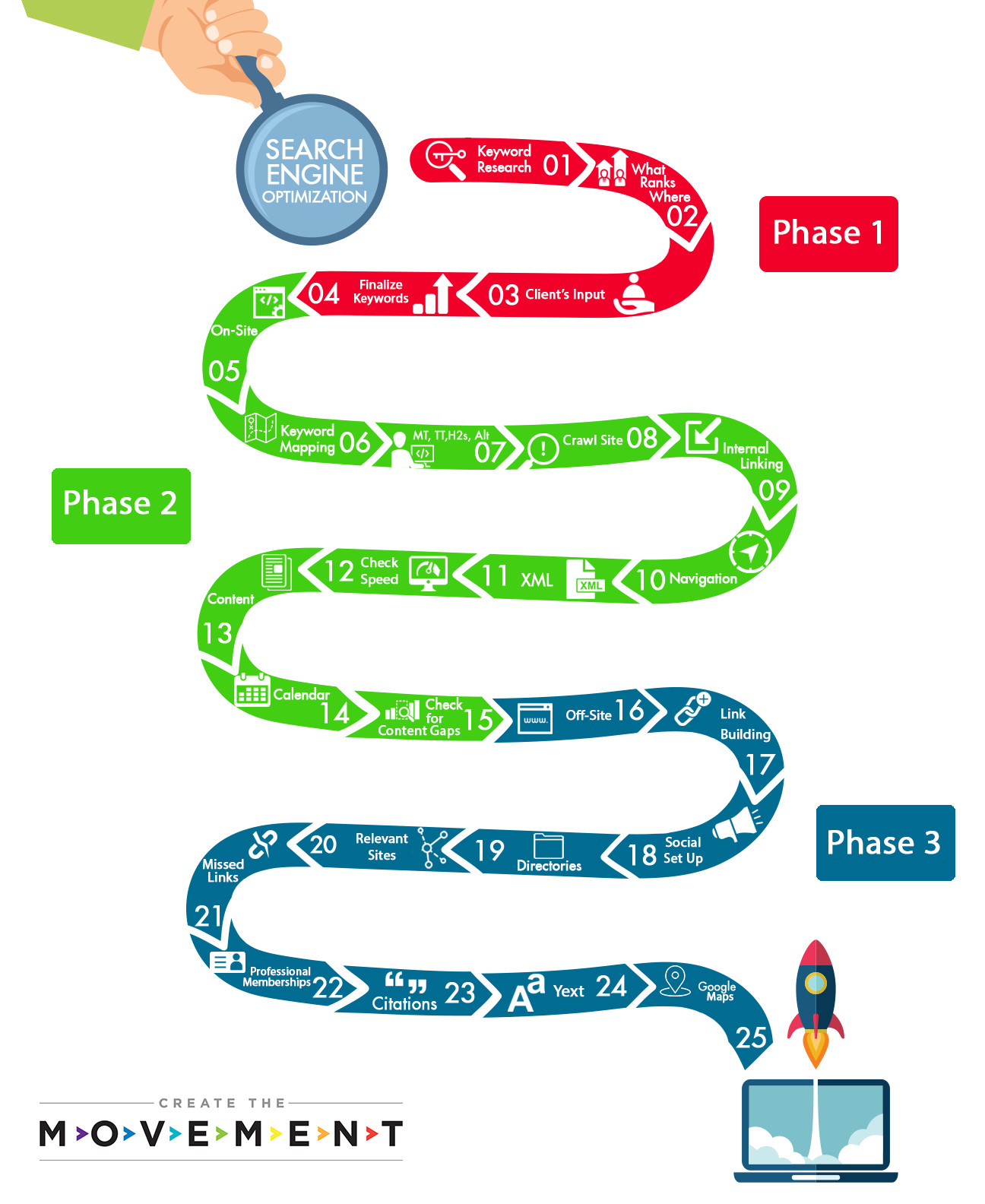Last week we talked about the importance of having a digital marketing strategy. To take things a step further, this week we’re pulling back the curtain and giving you an inside look at our SEO strategy.

Keywords
The first step in any SEO strategy is always keyword research. When doing keyword research we want to know three things: what the client already ranks for, what they want to rank for, and what they can actually and feasibly rank for.
The first one is fairly easy, we simply open our nifty tool box and run a “what ranks where” report. Once we have the data, we sift through everything to find any hidden momentum we can capitalize on. The second step is fairly easy too, we ask the client which keywords they want to rank for and which ones are the most lucrative.
The last step is the hardest. This is when we decide which keywords the site actually has a chance to rank for based on the client’s budget and timeline. Sometimes this involves an uncomfortable conversation where we inform the client that the competition is too high and their budget is too low.
When we pick keywords to focus on we’re looking for keywords with the highest search volume and the lowest competition. This doesn’t mean we’re afraid of a fight. We’ve climbed the ranking ladder for plenty of high competition keywords and come out on top (literally).
On-Site
Once we have the keywords we need, we take the XML sitemap and assign a keyword to every page on the site. This ensures proper keyword distribution and will identify any content gaps that need to be fixed. After creating the keyword map, we painstakingly go through every page on the site to attach proper keyword focused meta description, title tags, H2 tags and alt text.
While we’re browsing through all the pages, we stop to create an internal linking structure so your visitors (and the Google bots) can easily navigate your site. If we stumble across any navigation snafus, we make it a point to adjust the XML sitemap accordingly.
The next step in the process is to put the site through the ringer and do a full site audit to check any errors that might have slipped through the cracks. The most common errors we find are 404s which we quickly correct with a 301 redirect. This site audit will also give a run down of the site’s load speed. If the site is a bit sluggish, we can compress a file here and there to get your site moving like Usain Bolt.
Now that the site is in tip-top shape we can start looking ahead at a content calendar. When creating a content calendar, the goal is to fill any remaining content gaps and focus on dominating the target keyword list. We do this by finding long tail keywords, such as questions people commonly Google related to the keywords we’re targeting, and by reinforcing the primary keywords with regularly published content.
It’s important to note that Google uses a process known as Latent Semantic Indexing (LSI) to rank sites. In short, it means that you need to have keywords related to your targeted keywords on your site, not just your targeted keywords identically regurgitated all over your site 100 times. For example: if you want to rank for “spaghetti recipe” you’ll want to have words like pasta, noodles, spaghetti sauce, and meatballs on your site as well. When crafting content, we always take time to consider LSI.
Off-Site
Off-site SEO is about link building and citations. Backlinks are a ranking factor for organic results and citations are a ranking factor for local map listings. There’s some crossover between the two, but that’s generally how it works.
Link building involves getting links (backlinks) pointing to your site on other people’s site. We don’t just take a link from any site that will give us one, we have strict standards for the kind of site we take links from. This is because Google will penalize a site if it has a questionable backlink profile. When we go backlink hunting we want to see sites with: high domain/page authority, lots of traffic, highly relevant, and ideally a keyword focused anchor text.
There’s plenty of low-hanging fruit if you know where to look, and you can rest assured we know a honey hole or two. This is one area that will separate the wheat from the chaff when it comes to SEO companies. We have a long list of industry specific, high-quality links, and our list gets longer every day. While some SEO companies have to spend time (and the client’s money) doing research, desperately trying to find links, we have a bank of links ready to go.
This is not to say we have a plug and chug SEO process, we still do a ton of linking research, but we have eliminated a lot of leg work most SEO companies have to do.
A lot of the links on our lists are industry directory listings and social media platforms. These might sound inconsequential, but, if you know which listings and platforms to go after, it can be a fantastic shot in the arm to kick off an SEO campaign.
While we’re putting our personal list to work, we also check with the client to see if there might be any missed linking opportunity. These missed opportunities consist of professional associations (like BBB or Chamber of Commerce) the client already belongs to and anywhere else the client is mentioned on the web without a link attached to the reference.
Citations are like backlinks, but instead of a link pointing to your website a citation is anywhere your company name, address, and phone number (NAP) are listed on the internet. It’s important to keep all your citations exactly the same or Google won’t take your citations seriously. So if one citation says 123 Elm St and other says 123 Elm Street, you’re not getting the full benefit of those citations. To make sure our citations are absolutely identical, we use fancy software that seeks out listings to corrects or suppress any unruly citations. In fact, we are a Yext Certified Partner, which gives us an edge on the competition.
This will take care of the top 70 or so citation sites, but we don’t stop there. Just like links, we also have a list of citation sites that will skyrocket any site in the map listings. One citation we pay extra attention to is the Google map listings. This listing is a huge ranking factor in local results, so we always make sure the listing is claimed, has the correct NAP, and is full of descriptions and even a few photos.
The Next Steps
Once everything above is completed it becomes a game of monitoring a tweaking. We will continue to build links until the cows come home, and we always monitor everything with Google Analytics and a slew of other SEO tracking software to see what areas of the campaign need to be adjusted.











